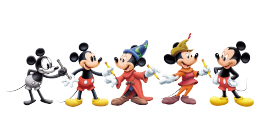“I always wanted to draw ever since I can remember,” Glen Keane once recalled, and as soon as he could hold a pencil in his hand, there was no stopping him. Throughout a life devoted to art—and nearly 38 years as an animator at The Walt Disney Studios—Glen’s towering imagination has dreamed up starry-eyed maidens, a coarse and unrefined beast who discovers love, and a diamond in the rough who became a prince.
Born April 13, 1954, Glen grew up in Paradise Valley, Arizona. His father, cartoonist Bil Keane, created the long-running Family Circus comic strip, and so sketch pads and freshly sharpened pencils were never difficult to find around the house.
Torn between his love of football and his desire to become an artist, Glen eventually decided to attend the California Institute of the Arts, enrolling in the Film Graphics program as an animation student. Despite initially not knowing anything about animation, he soon came to embrace the art form.
In September 1974, he accepted a position at Disney as an animator. Glen was one of a new generation of animators brought in to be tutored under Walt’s remaining veterans as they approached retirement.
To continue the legacy of Disney animation, this new class of artists would have to learn the tricks of the trade from the old-timers.
Glen learned from the masters, including Disney Legends Eric Larson, Frank Thomas, and Ollie Johnston. Their instruction served him well on his first major assignment, assisting Johnston in drawing Penny for 1977’s The Rescuers. He followed this with work on Elliott the Dragon for Pete’s Dragon (1977).
For The Fox and the Hound (1981), Glen helped animate Tod, Vixey, and the thrilling battle with a towering grizzly bear at the film’s climax. His work earned him praise for the force and weight he brought to the grizzly, as well as the visceral feel of the scene.
After doing conceptual work for The Small One (1978) and The Black Cauldron (1985), Glen found himself animating Willie the Giant for Mickey’s Christmas Carol (1983). During production, he caught a screening of Tron, Disney’s groundbreaking foray into computer animation. Impressed by the new art form, he began to discuss a new project with fellow animator John Lasseter; the two teamed up with MAGI, a computer animation company that had worked on Tron, to produce a revolutionary 30-second test that combined hand-drawn animation with computer-generated backgrounds. Based on the children’s classic Where the Wild Things Are, the demonstration project also marked Disney’s first experiment in digitally inking and painting characters.
Glen left the Company in 1983 to work as a freelance artist, although he continued to work on new Disney animated features. He returned to Disney to work on The Little Mermaid (1989), for which he animated the heroine Ariel. This began a slate of successful projects including The Rescuers Down Under (1990), for which Glen animated the golden eagle Marahute; Beauty and the Beast (1991), for which he animated the imposing Beast; and Aladdin (1992), for which he animated the titular desert rogue. He brought to life Pocahontas in 1995, and, after a sabbatical in Paris, tackled the title character for 1999’s Tarzan. He also animated the roguish John Silver for Treasure Planet (2002).
In 1996 Glen began work on a retelling of the Rapunzel story, which he would develop over the next decade. This project became the 2010 hit Tangled, for which he served as Executive Producer, Animation Supervisor, and Directing Animator for the character of Rapunzel.
Glen was the recipient of the 1992 Annie Award for Outstanding Individual Achievement in the Field of Animation for his work on Beauty and the Beast, and in 2007 he received the prestigious Winsor McCay Award for Lifetime Contribution to the Field of Animation.
Glen retired from Walt Disney Animation Studios in March 2012 to explore new directions in the animated art form. He continues to animate, teach, and inspire new generations of artists—and above all, he continues to draw



